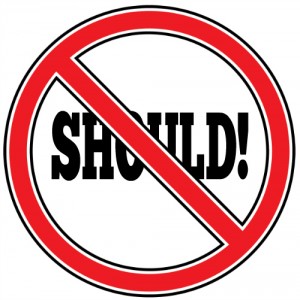Procrastination: Shoulda Woulda Coulda
By Gwen Rockwood, newspaper columnist and mama of 3
Like most writers, I have a dance partner whose name is Procrastination. I hate his guts. What a slacker. And yet we keep on dancing. We side-step and disco-delay until I’m up against a wall and have no choice but to kick him out and get down to work.
So in an effort to “know my enemy,” I’m reading a book about procrastination. (And yes, I’m fully aware that reading a book about procrastination might just be another way I’m procrastinating doing the actual work. But I’ve already admitted there’s a problem, so give a girl some credit.)
I’m about halfway through the book, which is titled The Now Habit, by Neil Fiore. It promises to not only explain how to stop procrastinating but also offer insight on why we do it in the first place.
Most people think procrastinators are sprawled out on the sofa watching the Kardashians get weirder by the second, while their work goes untouched and obligations get ignored. But that’s a misconception. Because a lot of procrastinators are a whirlwind of activity. We are what I’d call “productive procrastinators.”
It’s amazing the amount of work I can get done on other chores when there’s a more important project I’m actively avoiding. If my kitchen is spotless, it’s because I’ve been seeking escape at the bottom of a sink of sudsy dishes. If the pantry is pristine, it’s because I’m looking behind cans of green beans for the willpower to start that looming project.
I’m not alone in this, right? Please tell me I’m not alone. There are more than 1,700 books about procrastination on Amazon, so apparently many of us struggle with this push-pull between work and distraction. If you, like me, are sick of waiting around for that magical, extended block of inspired time to tackle a project, here are three things I’ve learned so far:
 Shoot the “should.” Most of us spend a large part of the day thinking about what we “should” do. But that’s kind of like carrying a cranky, finger-pointing school teacher around in our head all day, and our response is to resist the authority. The book advises us to recognize that what we do – or not do – is our choice, regardless of the consequences. So “choose” to do something or not to do it. Shoot the should.
Shoot the “should.” Most of us spend a large part of the day thinking about what we “should” do. But that’s kind of like carrying a cranky, finger-pointing school teacher around in our head all day, and our response is to resist the authority. The book advises us to recognize that what we do – or not do – is our choice, regardless of the consequences. So “choose” to do something or not to do it. Shoot the should.
Aim for half. Not half the project. Just half an hour. You can do almost anything for half an hour, right? Set a timer, work for 30 minutes and then stop or switch to something easier. That half-hour of time is long enough to get started (which is always the hardest part) but not long enough to feel like drudgery. Then (and this part is important) give yourself credit for that short burst of focused work. Write down each half-hour and total them up each week.
Nurture your inner toddler. When my kids were little, I’d often get them to clean up their toys by promising that we could go outside and play afterward. It made it easier for them to do the boring stuff because they knew fun stuff was coming up next.
Similarly, the book advises procrastinators to schedule our own version of playtime, like lunch with a friend, a trip to get coffee or some time to sit and do nothing. Knowing you’re carving out time to relax makes it easier to focus during work. And free time feels a lot more “free” when you’re not mentally beating yourself up about what you “should” be doing.
Finally, here’s a great line from the book, which speaks to the heart of any perfection-loving procrastinator: “Work for an imperfect, perfectly human first effort.”
Projects can’t ever get better if they never get started.
 Gwen Rockwood is a mom to three great kids, wife to one cool guy, a newspaper columnist and co-owner of nwaMotherlode.com. To read previously published installments of The Rockwood Files, click here. To check out Gwen’s new book, “Reporting Live from the Laundry Pile: The Rockwood Files Collection,” click HERE.
Gwen Rockwood is a mom to three great kids, wife to one cool guy, a newspaper columnist and co-owner of nwaMotherlode.com. To read previously published installments of The Rockwood Files, click here. To check out Gwen’s new book, “Reporting Live from the Laundry Pile: The Rockwood Files Collection,” click HERE.
Photo credit: Lisa Mac Photography
